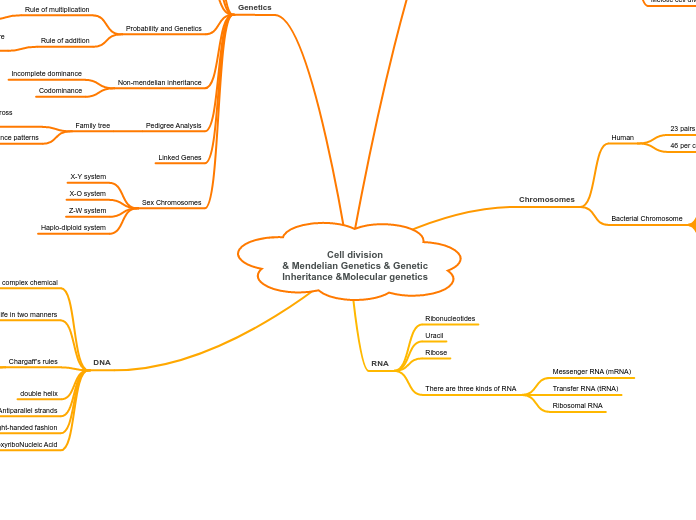Cell division
& Mendelian Genetics & Genetic
Inheritance &Molecular genetics
Cell division
Chromosome
Prokaryotic cell
Circular chromosome
Not associated with proteins
Eukaryotic cell
Prokaryotes
Binary fission
Eukaryotes
Mitotic cell division
Interphase
~90% of the cell cycle
- Can be divided into 3 phases
The cell grows during all three phases
Chromosomes are duplicated only during the S phase.
Mitosis and cytokinesis
Mitosis
Prophase
Prometaphase
Metaphase
Anaphase
Telophase
Cytokinesis occurs during telophase
In animal cells, cytokinesis occurs
by a process known as cleavage,
forming a cleavage furrow
In plant cells, a cell plate
forms during cytokinesis
Cells that can undergo mitotic cell division include
Epithelial cells, Bone marrow of animal tissues
Shoot and root apical meristems of plant tissue
Meiotic cell division
Objectives
. Sexual life cycle
To produce reproductive cells
Stage of Meiosis
prophase I
chromosome pairs with its homolog (synapsis) and crossing over occurs
metaphase I
pairs of homologs line up at the metaphase plate, with one chromosome facing each pole.
anaphase I
One chromosome of each pair moves toward opposite poles, guided by the spindle apparatus.
telophase I
Meiosis II
is very similar to mitosis
metaphase II
the sister chromatids are arranged at the metaphase plate
anaphase II
the sister chromatids separate.
telophase II,
the chromosomes arrive at opposite poles
Subtopic
Chromosomes
Human
23 pairs of chromosomes
46 per cell
Bacterial Chromosome
Double-stranded DNA
single circular chromosome
located in the cytoplasm
not bound with proteins
smaller circular DNA molecules
pick up new plasmids or lose them
Plasmids help bacteria to survive stress
RNA
Ribonucleotides
Uracil
Ribose
There are three kinds of RNA
Messenger RNA (mRNA)
Transfer RNA (tRNA)
Ribosomal RNA
Genetics
Gregor Johann Mendel
Experimented with pea plantsfor 8 year
F 1 progeny resembles one of the parents
In F 2, the missing trait reappears in ¼ of the progeny
The ratio of two classes of progeny was 3 : 1
Mendel’s Principles
genes become separated in gamete formation
Members of one gene pair segregate independently from other gene pairs during gamete formation
test-cross
To test the equal gamete formation in F1
Dominant phenotype couldbe either homozygous
dominant or heterozygous
breeding the mystery individual with a
homozygous recessive individual
Mendel’s Law of Segregation
Two alleles of the same gene segregate equally
Different pairs of alleles assort independently
Probability and Genetics
Rule of multiplication
Chance that 2 or more independent events will occur
together
– probability of Pp x Pp -> pp
Rule of addition
Chance that an event can occur 2 or more
different ways
– sum of the separate probabilities
– probability of Bb x Bb -> Bb
Non-mendelian inheritance
Incomplete dominance
Codominance
Pedigree Analysis
Family tree
interrelationships of parents and children across generations
Inheritance patterns
Linked Genes
Sex Chromosomes
X-Y system
X-O system
Z-W system
Haplo-diploid system
DNA
the complex chemical
dictates life in two manners
transfers hereditary information
from generation to generation
controls the production of proteins
Chargaff’s rules
The base composition of DNA varies between
species
A=T, C=G
double helix
Antiparallel strands
• Right-handed fashion
DeoxyriboNucleic Acid
